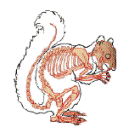
Let it ring: the hands of Phyllis Kirk and Gene Nelson in Crime Wave (dir. André De Toth, 1954).

Jim Hayward, the maniacal Timothy Carey, and Charles Buzinsky (Charles Bronson).

Sterling Hayden.
It may be all you need to know about Crime Wave that noirologist and (apparently) full-time DVD commentator Eddie Muller is joined in the commentary track by James Ellroy, and that Ellroy just about has kittens. Yes, it does hurt his credibility a bit that he's such a complete spaz (he pants excitedly when he sees locations he likes, and growls so loudly at the mere mention of attractive actresses that he hurts Muller's ears). The same might be said for his off-the-cuff declaration mid-viewing that De Toth's film is not only better than Kubrick's The Killing (which was inspired in part by it), but better than Chinatown. It might be said, except that part of me agrees with him. Yes, it's the impetuous part. I would give anything to have been at the dinner Ellroy promised to buy Muller after the commentary, at which, he said, he would defend his provocative claim at length.
All right, it's just a low-budget heist flick shot in thirteen days. But everything in it clicks. Sterling Hayden as toothpick-chewing monster cop Det. Lt. Sims (Ellroy takes one look at him and says, "Fuck Russell Crowe in LA Confidential; that's Bud White!"). Phyllis Kirk, who plays the devoted wife of ex-con Gene Nelson as though she were a three-dimensional character, despite all attempts by the script to sabotage her. Gene Nelson's souped-up Deuce Coup. Ted de Corsia (the rabbit-punching Willie the Harmonica from Naked City) as a bullying gangleader (though his bullying comes in second to Hayden's). The young Charles Bronson, going by Charles Buzinsky, as a scary punk. And the even scarier Timothy Carey (who, along with Hayden and de Corsia, was drafted by Kubrick for the aforementioned The Killing).
Then there's the location shooting in Los Angeles and environs. The opening sequence of the gas station hold-up alone is a work of art. (During the titles, you see the gangsters' car pull up to the station window as the attendant raises his head to greet them--then, after the director's credit, the last ten or so seconds of film runs all over again, the attendant raising his head for a second time! And immediately following this, there is a severe change of camera angle that almost gives the effect of a jump cut. I don't know if this was an intentional stab at artsiness by De Toth and/or veteran John Ford cameraman Bert Glennon, but I can just see Godard watching it and flipping his lid.) Just about every frame in the film is composed as though it were being made for the Academy's consideration, and the settings are used to full advantage, from the actual interior of the LA Police Department to a grimy lunchroom to a little animal hospital to a big barn of a bank in Glendale. There's one scene that begins in total darkness, and suddenly a door at the right of the frame bursts open like a rectangular lightning bolt as the police bust in, throwing their shadows around in dramatic ways. I had to replay it three times.
I watched this a couple of nights ago, and I'm still high on it. It's on a double-bill DVD with Jack Bernhard's Decoy, which I'll talk about in my next post.



2 comments:
Wow. Sounds like I'll have to check this one out!
me too.
Post a Comment